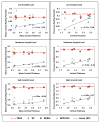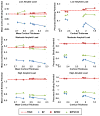Partial volume correction in quantitative amyloid imaging
- PMID: 25485714
- PMCID: PMC4300252
- DOI: 10.1016/j.neuroimage.2014.11.058
Partial volume correction in quantitative amyloid imaging
Abstract
Amyloid imaging is a valuable tool for research and diagnosis in dementing disorders. As positron emission tomography (PET) scanners have limited spatial resolution, measured signals are distorted by partial volume effects. Various techniques have been proposed for correcting partial volume effects, but there is no consensus as to whether these techniques are necessary in amyloid imaging, and, if so, how they should be implemented. We evaluated a two-component partial volume correction technique and a regional spread function technique using both simulated and human Pittsburgh compound B (PiB) PET imaging data. Both correction techniques compensated for partial volume effects and yielded improved detection of subtle changes in PiB retention. However, the regional spread function technique was more accurate in application to simulated data. Because PiB retention estimates depend on the correction technique, standardization is necessary to compare results across groups. Partial volume correction has sometimes been avoided because it increases the sensitivity to inaccuracy in image registration and segmentation. However, our results indicate that appropriate PVC may enhance our ability to detect changes in amyloid deposition.
Keywords: Amyloid imaging; PET; Partial volume correction; PiB.
Copyright © 2014 Elsevier Inc. All rights reserved.
Figures





References
-
- Aisen PS, Andrieu S, Sampaio C, Carrillo M, Khachaturian ZS, Dubois B, Feldman HH, Petersen RC, Siemers E, Doody RS, Hendrix SB, Grundman M, Schneider LS, Schindler RJ, Salmon E, Potter WZ, Thomas RG, Salmon D, Donohue M, Bednar MM, Touchon J, Vellas B. Report of the task force on designing clinical trials in early (predementia) AD. Neurology. 2011;76:280–286. - PMC - PubMed
-
- Aizenstein HJ, Nebes RD, Saxton JA, Price JC, Mathis CA, Tsopelas ND, Ziolko SK, James JA, Snitz BE, Houck PR, Bi W, Cohen AD, Lopresti BJ, DeKosky ST, Halligan EM, Klunk WE. Frequent amyloid deposition without significant cognitive impairment among the elderly. Arch Neurol. 2008;65:1509–1517. - PMC - PubMed
-
- Bateman RJ, Xiong C, Benzinger TL, Fagan AM, Goate A, Fox NC, Marcus DS, Cairns NJ, Xie X, Blazey TM, Holtzman DM, Santacruz A, Buckles V, Oliver A, Moulder K, Aisen PS, Ghetti B, Klunk WE, McDade E, Martins RN, Masters CL, Mayeux R, Ringman JM, Rossor MN, Schofield PR, Sperling RA, Salloway S, Morris JC. Clinical and biomarker changes in dominantly inherited Alzheimer’s disease. N Engl J Med. 2012;367:795–804. - PMC - PubMed
-
- Bousse A, Pedemonte S, Thomas BA, Erlandsson K, Ourselin S, Arridge S, Hutton BF. Markov random field and Gaussian mixture for segmented MRI-based partial volume correction in PET. Phys Med Biol. 2012;57:6681–6705. - PubMed
Publication types
MeSH terms
Substances
Grants and funding
- R01 AG040060/AG/NIA NIH HHS/United States
- P30 AG062421/AG/NIA NIH HHS/United States
- P01 AG026276/AG/NIA NIH HHS/United States
- UL1 TR001108/TR/NCATS NIH HHS/United States
- P01AG003991/AG/NIA NIH HHS/United States
- P30 NS048056/NS/NINDS NIH HHS/United States
- P30NS048056/NS/NINDS NIH HHS/United States
- U19AG032438/AG/NIA NIH HHS/United States
- U19 AG032438/AG/NIA NIH HHS/United States
- P41 EB015922/EB/NIBIB NIH HHS/United States
- P01AG026276/AG/NIA NIH HHS/United States
- UL1 TR000005/TR/NCATS NIH HHS/United States
- R01 AG019771/AG/NIA NIH HHS/United States
- T32 GM008151/GM/NIGMS NIH HHS/United States
- RF1 AG041915/AG/NIA NIH HHS/United States
- P01 AG003991/AG/NIA NIH HHS/United States
- P50 AG005681/AG/NIA NIH HHS/United States
- U54 EB020403/EB/NIBIB NIH HHS/United States
- P50 AG005134/AG/NIA NIH HHS/United States
- P50AG005681/AG/NIA NIH HHS/United States
- P01 NS080675/NS/NINDS NIH HHS/United States
LinkOut - more resources
Full Text Sources
Other Literature Sources
Research Materials

